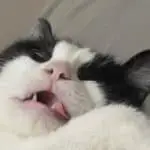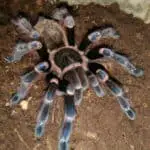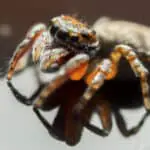Have you ever woken up to the gentle touch of your cat’s paw on your face and wondered why they do that?
Cats, with their mysterious aura and enigmatic behaviors, often leave us guessing about their intentions. But when they choose to touch our faces with their paws, it’s more than just a random act.
It’s a world full of affection, communication, and deep-seated instincts. From expressing their love and seeking attention to mimicking human behavior and even performing health checks, each gentle tap has a story to tell.

In this exploration, we’ll unravel the fascinating reasons behind this endearing feline behavior and how you, as a beloved cat owner, can understand and respond to these tender gestures.
Get ready to delve into the charming world of your feline friend’s paw language!
Affectionate Bonding

Affectionate bonding between a cat and its owner is a unique and special aspect of their relationship. When a cat paws your face, it’s often a display of trust and affection.
This behavior stems from kittenhood when kittens knead their mother’s belly to stimulate milk flow. As they grow, this kneading action evolves into a comforting gesture that signifies contentment and love.
When your cat gently paws at your face, it’s trying to recreate that warm, nurturing bond it felt as a kitten. This is their way of showing that they feel safe and loved around you. It’s also a sign that your cat views you as a parental figure, providing them with security and comfort.
In response to this affectionate gesture, it’s important to be gentle and loving. Speak softly to your cat, showing appreciation for this sign of trust.
You can gently stroke or pet your cat, especially in their favorite spots like under the chin or behind the ears. This not only reinforces the bond but also makes your cat feel cherished and secure.
Avoid any harsh reactions, even if their pawing wakes you up or feels a bit intrusive at times. Remember, this behavior is a significant expression of their love for you.
If you prefer your cat not to paw at your face, you can gently redirect their paws away while still showing affection. Over time, your cat will learn your boundaries while maintaining the strong bond you share.
Marking Their Territory

Marking their territory is a deeply ingrained behavior in cats, and when they paw at your face, they’re engaging in a subtle form of this practice.
Cats have scent glands located in their paws, and by touching your face, they’re transferring their scent onto you. This is their way of claiming you as part of their territory, a sign that you are an important and trusted part of their world.
This behavior is rooted in their instinct to establish and maintain their presence within a territory. In the wild, cats mark trees, rocks, and other surfaces to communicate their presence to other cats.
When it comes to their human companions, marking serves a similar purpose – it’s a way for them to express their connection to you and to include you in their ‘territory’.
When your cat paws your face to mark you, it’s best to respond with affection. Understand that this is a sign of their trust and attachment to you.
You can gently stroke or pet them in return, showing that you accept and reciprocate their affection. This positive reinforcement helps strengthen your bond and makes your cat feel secure and loved.
However, if this behavior becomes too frequent or bothersome, you can gently redirect your cat’s paws away from your face. It’s important to do this in a gentle manner without scolding them, as they are simply acting on their natural instincts.
Over time, with consistent redirection and positive reinforcement, your cat may learn to express their territorial marking in ways that are more comfortable for you.
Seeking Attention

When your cat paws at your face, it often means they are seeking attention. This behavior is a direct and effective way for cats to communicate their need for interaction, whether it’s for play, affection, or even food.
Cats are intelligent creatures who quickly learn what actions get them the response they desire from their owners. Pawing your face could be their learned method of saying, “Look at me, I need you right now.”
This behavior might occur when your cat feels lonely, bored, or simply because they enjoy your company and want to engage with you. It’s important to understand that such actions are not just attention-seeking but also a sign of the strong bond your cat has with you. They see you as their trusted companion and source of comfort.
Responding to this behavior positively reinforces your bond with your cat. If they paw your face for attention, take a moment to engage with them.
You can pet them, talk to them in a soothing voice, or even engage in a play session if they seem energetic. Providing them with toys or initiating play can also redirect their need for attention in a more appropriate way.
However, if you’re unable to attend to your cat immediately, gently guide their paw away and offer a soft but firm “not now.” Later, when you have the time, initiate interaction with your cat to show that you’re available and willing to give them the attention they crave. It’s a balance of responding to their needs and teaching them appropriate ways to seek your attention.
Remember, consistent and loving interactions will strengthen your relationship with your cat, making them feel loved and secure while also respecting your boundaries.
Curiosity and Play

Curiosity and play are essential aspects of a cat’s behavior, and when they paw at your face, it can be a manifestation of these traits.
Cats are naturally curious animals, and your face, with its various features and expressions, presents a fascinating and interactive landscape for them to explore. This behavior can also be a playful invitation, as cats often use their paws to initiate play sessions, mimicking their natural hunting behaviors.
When your cat paws your face out of curiosity or a desire to play, they are engaging with you in a way that stimulates their mind and satisfies their playful instincts. This is particularly common in younger cats or those with a high play drive.
They may be intrigued by your facial movements, such as blinking, smiling, or talking, and pawing at your face is their way of interacting with these interesting movements.
Responding to this behavior can be both fun and enriching for your cat. If you’re comfortable with the pawing, you can engage in gentle play, using soft and playful gestures to interact with your cat.
You can also redirect their energy to a toy, encouraging them to paw at something more appropriate. Interactive toys, like feather wands or laser pointers, can provide a healthy outlet for their curiosity and playfulness.
If the behavior is not appropriate or becomes too rough, you can gently discourage your cat by stopping the interaction and redirecting their attention elsewhere. It’s important to be consistent in your response, so your cat learns what is acceptable behavior when interacting with you.
Communication

When your cat paws at your face, it’s not just a random action; it’s a form of communication. Cats are not as vocal as dogs, so they rely more on body language to express their needs and feelings.
This gentle pawing could be their way of conveying a variety of messages, such as wanting food, desiring affection, or simply saying hello. Each cat has its own unique way of communicating, and pawing at your face might be their chosen method to connect with you.
Understanding this, it’s crucial to pay attention to the context and other body language cues your cat displays when they paw at your face.
Are they purring, indicating contentment? Are their ears pointed forward, showing curiosity or interest? Or are they meowing, possibly indicating hunger or a desire for attention?
By observing these signs, you can better understand what your cat is trying to tell you.
In responding to this form of communication, it’s important to be attentive and empathetic. If your cat seems to be asking for food or water, check their bowls. If they appear to be seeking affection, give them some gentle pets or cuddle time. If they’re simply saying hello, acknowledge them with a soft voice or a gentle stroke.
However, if this behavior becomes excessive or bothersome, it’s important to set boundaries in a gentle way. You can slowly redirect their paw away while still giving them some attention, teaching them that while their communication is valued, they also need to respect your space.
Imitating Behavior

Cats are highly observant creatures and often mimic behaviors they see. When your cat paws at your face, it could be an instance of imitating human behavior.
They may have noticed how you touch your own face or observed how humans interact with each other, involving facial touches. In trying to be a part of your ‘world’, your cat might replicate these actions, seeing it as a way to bond and communicate with you.
This imitative behavior is a sign of your cat’s intelligence and their desire to be closer to you. It shows that they are paying attention to your actions and are attempting to engage with you in a manner they perceive as affectionate or sociable.
When responding to this behavior, it’s important to consider the intent behind it. If your cat is gently pawing at your face in an attempt to interact, responding with gentle petting or soft verbal communication can reinforce this positive behavior.
It’s a way to acknowledge their effort to connect with you and deepen the bond between you.
However, if the pawing is persistent or becomes inconvenient, you can guide your cat’s paw away gently and redirect their attention to another form of interaction, like a toy or a different kind of petting.
This way, you’re not discouraging their attempt to communicate and bond but are instead guiding them towards more appropriate ways of interaction.
Comfort-Seeking

When cats paw at your face, it can often be a sign of comfort-seeking. This behavior is rooted in their kittenhood; as kittens, they knead their mother’s belly to stimulate milk flow. As they grow, this kneading action becomes a soothing habit, a way for them to self-comfort and express contentment.
When your cat does this to your face, it’s a sign that they feel completely safe and comfortable with you. They are seeking the same warmth and security they experienced with their mother.
This comfort-seeking behavior is a profound demonstration of trust and affection. Your cat is showing that they view you as a source of comfort and safety, much like their maternal figure. It’s a gesture that indicates deep emotional connection and reliance on you for emotional support.
In responding to this behavior, it’s important to show that you understand and appreciate their need for comfort. You can gently pet them, using soft, soothing strokes that mimic the gentle touch of a mother cat. Speak to them in a calm and loving tone to reinforce the feeling of safety and security.
However, if your cat’s kneading is uncomfortable, especially if they use their claws, you can gently hold their paws or redirect them to a soft blanket or a plush toy. This way, they can continue their comforting behavior without causing any discomfort to you.
By responding with patience and affection, you reinforce your role as their trusted guardian and deepen the emotional bond between you. Understanding and catering to their comfort-seeking behavior is a key part of nurturing a loving and trusting relationship with your cat.
Health Check
Cats are not only affectionate but also very intuitive creatures, and sometimes, their pawing at your face can be a form of a health check. Cats have a heightened sense of detecting changes in their environment, including changes in their owner’s health.
It’s believed that cats can pick up on subtle differences in behavior, scent, or even changes in body temperature. When your cat paws at your face, they might be responding to these changes, showing concern, or trying to understand what’s different.
This behavior is a testament to the deep bond cats share with their owners. They are sensitive to your well-being and may become more attentive or affectionate if they sense something is amiss. Your cat’s pawing could be their way of ‘checking in’ on you, ensuring that you are alright.
In responding to this behavior, it’s important to recognize the care and concern behind it. Gently petting your cat or speaking to them in a soothing voice can be reassuring to both you and your cat. It’s a way of letting them know that you appreciate their concern and that you’re there for them, too.
However, if your cat’s behavior changes significantly or becomes overly persistent, it could be a sign that they are stressed or anxious about the changes they sense. Maintaining a calm and comforting environment, along with regular vet check-ups, can help ensure that both you and your cat stay healthy and happy.








